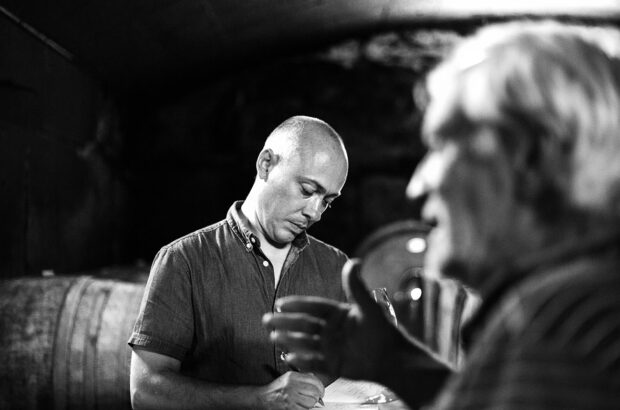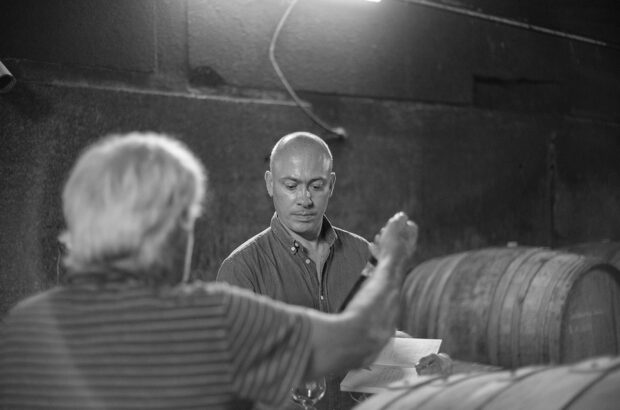The consultant physician and cabaret guitarist regales Rosi hanson with tales of university imbibing, Pétrus at a steal, and all that Burgundy
It’s hard to keep up with the ebullient Dr David Barlow. Consultant physician in genito-urinary medicine, an expert in transmission of HIV in heterosexuals and the publisher of many papers on gonorrhoea (‘your readers may not wish to know this’), you might think he’d be a serious chap.
Not a bit. He’s a singer of humorous songs, plays guitar, spoons and harmonica with cabaret act Instant Sunshine; in short he’s a man of eclectic interests and boundless enthusiasms. But then I guess you’d need a bit of light relief after all that disease.
Wine was always part of Barlow’s life. His father, also a consultant physician, had been a member of the Claret Club at Trinity College, Oxford in the 1930s. When Barlow followed him there, on an open scholarship in maths and physics, he found silver service at all meals and a fine cellar available for the undergraduates.
He has fond memories of Graham’s 1955 for £1 and a shilling: ‘If only I’d squirrelled it away rather than scoffed it.’ At Oxford he became friends with the late Miles Kington, who later became bass player for Instant Sunshine.
He met the other members at St Thomas’ medical school in 1965 where he directed a Christmas show which spawned Instant Sunshine. As the medical students morphed into doctors and then consultants, they carried on performing, squeezing in live shows and radio work around medical duties.
An introduction to Peter Noble of Christopher’s wine merchants in London led to tasting invites. ‘I remember my first exposure to pudding wine – a corked Château Coutet – and a tasting of 1961 Bordeaux, which I found undrinkable. I bought none. Arrrrggh!’ he wails at the missed opportunity.
Now he is in full flow, touching on the Alexander Technique (he is the great-nephew of the eponymous Alexander), bird watching, and the menu he cooked recently for 40 European venereologists. There’s a detour to his study for photos of a recent lecture tour in Sri Lanka, and his latest hand-made guitar, one of 12. And we haven’t even started on his real passion: his cellar.
In the 1970s, he began buying at Christie’s auctions. ‘I bought Cos d’Estournel 1970 at £20 a case, and 20 cases of halves of Liot 1972, a chaptalised off-year Barsac which gave great pleasure. Later, I bought two cases of La Chapelle Hermitage ’78 for £160 each – great joy when Jancis Robinson’s Vintage Timecharts book came out in 1989 and this wine had the longest predicted life of all; I still have six bottles.’
He thinks it was 1979 when he stumbled on Pétrus 1976 at £135 a case in Army & Navy. ‘I bought one and was virtually dismembered by my wife – we were perpetually in debt with three kids.’ No surprise to her, I’m sure, that he went back the next day for another. And would have done it again if it hadn’t sold out.
En primeur acquisitions were intended as an investment to help with school fees. The only claret he ever disposed of was three cases of 1975 Mouton, Latour and Lafite, swapped for Mugnier’s Les Amoureuses Chambolle-Musigny 1989 and Les Fuées ’92; Simon Bize’s Aux Guettes and Les Marconnets, Savigny-lès-Beaunes, both 1989; and Olivier Leflaive’s Clos du Cromin Meursault ’86.
His highlights: ‘Haut-Brion 1979 was startlingly good. Cheval Blanc ’64 was not a popular year but phenomenally good – the best claret I’ve ever had.’ La Mission ’66 and Lafite ’66 and ’83 have been other high points. And he’s happy to have a few bottles of Malescot-St-Exupéry1975.
In the well-organised racks he points out a bottle of Château Grillet 1990, a Romanée-St-Vivant ’61 and a Vosne-Romanée ’82. As for fizz, ‘I’m not a great one for old bubble-less Champagne’, so there’s a bottle of Moët 1978 and Krug ’69 which he’s saving for a special occasion.
Australian Cabernet is represented by Orlando Barossa Cabernet 1970 from G Grange & Sons. There are some German wines, and Alsace from Rolly Gassmann and Bruno Sorg. An Instant Sunshine performance in the Loire resulted in Jean-Paul Mabileau’s St-Nicolas-de-Bourgueil 1985 – ‘not Cheval Blanc’, but still Cabernet Franc of a high standard.
Everyday drinking is mainly Henri Naudin-Ferrand, including a ‘spiffing’ Aligoté Vieilles Vignes and Hautes-Côtes de Beaune and Hautes-Côtes de Nuits red and white. ‘We have a lot of Chablis from Goisot at St-Bris-le-Vineux in Côtes d’Auxerre and from Domaine Felix nearby, bought at the cellar door on the way back from skiing’. All in all, a decent lot. So any regrets? ‘I didn’t buy enough 2000s.’
Written by Rosi Hanson






